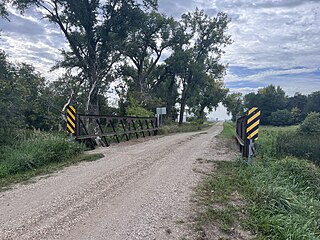
Revere Beach Parkway is a historic parkway in the suburbs immediately north of Boston, Massachusetts. It begins at Wellington Circle in Medford, where the road leading to the west is Mystic Valley Parkway, and the north–south road is the Fellsway, designated Route 28. The parkway proceeds east, ending at Eliot Circle, the junction of Revere Beach Boulevard and Winthrop Parkway in Revere. In between, the parkway passes through the cities of Everett and Chelsea. The parkway was built between 1896 and 1904 to provide access from interior communities to Revere Beach. It underwent two major periods of capacity expansion, in the 1930s and again in the 1950s. The parkway is designated as part of Route 16 west of Route 1A, and as part of Route 145 east of that point.

The Sorlie Memorial Bridge, also known as the Red River Bridge, was constructed in 1929 by the Minneapolis Bridge Company to connect the cities of Grand Forks, North Dakota and East Grand Forks, Minnesota. It was placed on the National Register of Historic Places in 1999.
The South Dakota Department of Transportation (SDDOT) is a state government organization in charge of maintaining public roadways of the U.S. state of South Dakota. South Dakota has 82,447 miles of highways, roads and streets, as well as 5,905 bridges. The SDDOT is responsible for 7,830 miles of the roadway system.

Hammond Pond Parkway is a historic parkway in Chestnut Hill, Massachusetts. The road, built in 1932, extends 2 miles (3.2 km) from Hobart Road in Newton to Horace James Circle in Brookline, where it joins the West Roxbury Parkway. It was designed by Charles Eliot and the Olmsted Brothers to provide a parkway setting that provided access from Brookline, Newton, and the western portions of Boston to the southern parks of the Emerald Necklace. The parkway was listed on the National Register of Historic Places in 2004.

Midway Bridge near Johnstown, North Dakota is the only bedstead bridge known to have been built in North Dakota. It appears to have been built locally, not as part of a state or county program, during the 1920-1930 period. Also known as Bedstead Bridge, it is a Warren Bedstead-type truss bridge.

The Ost Valle Bridge is a bridge near Thompson, North Dakota that was listed on the National Register of Historic Places in 1997. It crosses an unnamed tributary of the Red River, about one mile west of the Red River itself. It is "one of the two oldest documented bridges in Grand Forks County that were built by long-term county bridge builder, the Jardine & Anderson".
Crystal Bridge in Crystal, North Dakota is a bridge which was built in 1927 over the Cart Creek. It was listed on the National Register of Historic Places in 1997.

The Cedar Creek Bridge near Haynes, North Dakota, United States, is a Pratt through truss structure that was built in 1908. It was listed on the National Register of Historic Places (NRHP) in 1997.

The Great Northern Railway Underpass at Stanley, North Dakota is a concrete deck girder bridge that was built in 1937. It is listed on the National Register of Historic Places.
The Knife River Bridge near Stanton, North Dakota, is a Pratt through-truss structure that was built in 1898. It was listed on the National Register of Historic Places in 2001.

The Norway Bridge near Mayville, North Dakota is a Pratt pony truss structure that was built in 1912 over the Goose River. It was listed on the National Register of Historic Places in 1997.

The West Park Bridge across the Sheyenne River in Valley City, North Dakota is a concrete false arch structure that was built in 2007. Together with the corresponding East Park Bridge, it brings Valley City's 4th Street across an oxbow of the Sheyenne River. The bridge is a sympathetic replacement for a historic bridge, built in 1924, that was listed on the National Register of Historic Places in 1997.

The Blanchard Bridge, also known as Elm River Bridge, near Blanchard, North Dakota was a Pratt through truss structure that was built in 1900 by Dibley & Robinson. It was listed on the National Register of Historic Places in 1997. It was removed from the National Register in 2009.

The Liberty Memorial Bridge, across the Missouri River connecting the "twin cities" of Bismarck and Mandan, North Dakota, also known as Missouri River Bridge, was a Warren-Turner through truss structure that was built in 1920. It was listed on the National Register of Historic Places in 1997. It was replaced by a new bridge in 2008 and removed from the National Register in 2009.
The Porter Elliott Bridge, also known as Goose River Bridge, near Hillsboro, North Dakota is a Warren through truss structure that was built in 1902 over the Goose River. It was previously listed on the National Register of Historic Places, but was removed in 2009.
The Portland Park Bridge, also known as South Branch Goose River Bridge, near Portland, North Dakota is a Pratt through truss structure that was built in 1919 over the south branch of the Goose River. It was listed on the National Register of Historic Places. It was removed from the National Register in 2004.

The Midland Continental Railroad Depot in Wimbledon, North Dakota, United States, was built in 1913 to the east of downtown, on 17th Street SE, and was moved to 401 Railway Street in 1920. It was listed on the National Register of Historic Places in 2003.

The South Street Bridge is a historic Pratt truss bridge, carrying Vermont Route 31 across the Poultney River just south of the village center of Poultney, Vermont. Built in 1923, it is one of a small number of surviving Pratt through trusses in the state, and one of just three that survives from the period before the state's devastating 1927 floods. It was listed on the National Register of Historic Places in 2009 as Bridge 4.
The Burlington Railroad Overpass is a historic structure northwest of Chariton, Iowa, United States. It spans the BNSF Railway tracks for 322 feet (98 m). The Iowa State Highway Commission (ISHC) designed several steel deck arch bridges in the 1930s to replace grade railroad crossings. The three-hinge arch is supported by concrete arch pedestals and was designed to cross the Chicago, Burlington and Quincy Railroad tracks. ISHC contracted with Ben Cole and Son of Ames, Iowa in 1936 to build the structure, which was completed a year later. The roadway has been widened, and guardrails have been replaced in subsequent years. It is the only example of this bridge type left in the state. It was listed on the National Register of Historic Places in 1998.

The Midland Continental Railroad is a defunct shortline railroad which operated in the U.S. state of North Dakota between 1906 and 1966. The railroad was envisioned as a trunk line running from Winnipeg, Manitoba, Canada to Galveston, Texas. Financing problems led to the completion of only two segments totalling 77 miles (124 km).















